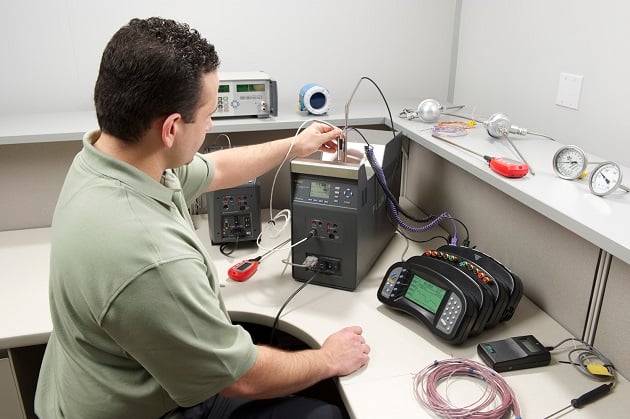- Other Fluke companies:
- Fluke
- Fluke Biomedical
- Fluke Networks
- Fluke Process Instruments
How to calibrate a thermocouple
Thermocouples are common in industry because they are inexpensive and cover a wide temperature range. They should be tested during commissioning and again when removed from a process to verify that the tolerances were met. You’ll also want to test thermocouples at regular calibration intervals and if you suspect them of failing to meet performance specifications.
Because of their unique characteristics, it’s best to calibrate thermocouples in situ (in place) by comparison to a temperature standard. If that isn’t practical, remove the thermocouple and place it in a precision temperature source such as a dry-well calibrator.

To calibrate a thermocouple, follow these steps:
- Isolate the sensor (thermocouple) from the process.
- Immerse the sensor fully into a dry-well or bath that can cover the required temperature range.
- Disconnect the thermocouple from the electronics if you want to check the calibration separately from the control system temperature indicator.
- Connect the thermocouple to a precision instrument capable of measuring millivolts. Some dry-wells have the required electronics built in; alternately you could use a thermometer readout.
- Does the thermocouple have a reference junction? If it does not, ensure that the precision voltage measurement device has reference junction compensation turned on. This may be identified as RJC or CJC. If the thermocouple does have a reference junction, ensure that it is also immersed at the required reference temperature. Usually, this is 0 °C.
- Adjust the temperature of the bath or dry-well to each of the test points.
- At each test point, record the readings of the temperature standard and thermocouple.
- If you are measuring the thermocouple separately from its measurement electronics, compare the measured voltage to the expected voltage from the applicable temperature table. Otherwise, compare the reading on the instrument display to the reading of the temperature standard.
Want to learn more about calibrating thermocouples? Check out our Thermocouple Application Note Series for more in-depth information.
- Login or register to post comments
- Printer-friendly version »
- Home
- Products
- New Products
- Electrical Calibration
- RF Calibration
- Data Acquisition and Test Equipment
- Temperature Calibration
- Humidity Calibration
- Pressure Calibration
- Flow Calibration
- Process Calibration Tools
- Calibration Software
- Service and Support
- All Calibration Instruments
- Handheld Test Tools
- Purchase Info
- News
- Training and Events
- Literature and Education
- Service and Support
- About Us



